M4A1E9 Sherman Tank
Sherman M4A1E9 Medium Tank at the Dutch National Military Museum (Nationaal Militair Museum) near Soesterberg the Netherlands.
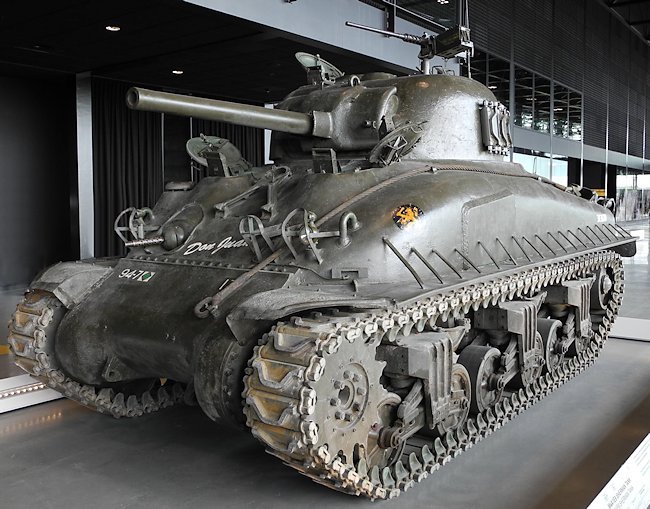
Sherman M4A1E9 Medium Tank at the Nationaal Militair Museum near Soesterberg the Netherlands.(Photos: Jan Wim Hasselman)
Location
The Dutch National Military Museum (Nationaal Militair Museum) can be found at Verlengde Paltzerweg 1, 3768 MX Soest, south east of Amsterdam between Utrecht and Amersfoort in the Netherlands. It is closed on Monday. It is open Tuesday - Sunday from 10.00 untill 17.00. It is also closed on 25th December, 1st January and 27th April. By train and bus from Amersfoort station, take bus 52 towards Utrecht or bus 56 towards Wijk bij Duurstede. Get off at the "’t Zwaantje" bus stop in Soesterberg. From there, it is approximately a 15-minute walk. From Utrecht Central Station, take bus 52 towards Amersfoort. Get off at the "’t Zwaantje" bus stop in Soesterberg. From there, it is approximately a 15-minute walk.
Specifications
The M4A1E9 was powered by a Ford GAA V8 petrol/gasoline engine. It had a maximum road speed of 30 mph (48 km/h) and an operational range of around 120 miles (193 km). It has a five man tank crew: commander, driver, co-driver/hull machine gunner, gunner and loader. They were protected by armour plating that offered around 50mm of frontal armor at a 45 degree angle, offering 70mm of armor in relative thickness
The tanks main gun was a 75mm M3 L/40. The tank could carry 90 rounds of high explosive HE, smoke and armour piercing AP rounds. A 30-6- Browning M1919A4 machine gun was mounted in the hull and also next to the main gun in the turret. Some tanks had a .50 cal Browning M2HB machine gun fitted to the outside of the turret.
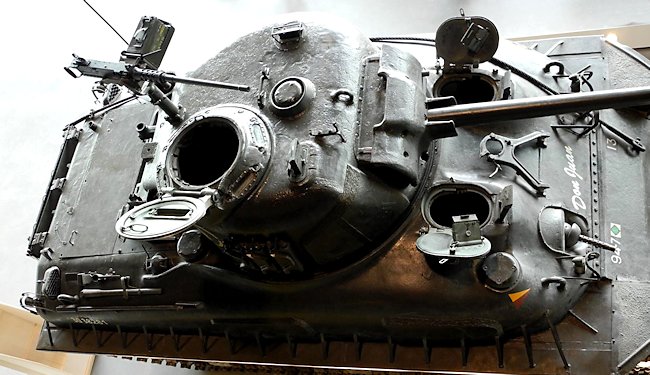
Sherman M4A1E9 Medium Tank has small hatches on the hull. The A shaped gun lock was used when the tank was being transported or being driven long distances along way from the front line. (Photos: Jan Wim Hasselman)
This is one of the fifty M4A1E9 Sherman Tanks's the Netherlands received in 1951 under MDAP. It was used on a live firing range as a hard target. It was rescued from that range in the 1970s and was restored as a WW2 war memorial to represent a Canadian Army Sherman. It is not an actual Sherman used by the Fort Garry Horse Regiment during the liberation of the Netherlands. It is just painted to look like one. In fact the Canadian Army did not use the M4A1E9 version of the Sherman tank.
A variety of Shermans were used in Canadian units after the adoption of the tank in the spring of 1943. The main variants used in armoured and armoured reconnaissance regiments were the Sherman III (the designation used by Commonwealth forces for the M4A2) and the Sherman V (M4A4). They also used the Canadian built Grizzly tank was a copy of the M4A1 (Sherman II) which did not see overseas service; the Ram was used in the U.K. for training, and variants were used in Northwest Europe in various functions, including command post, observation post, and armoured personnel carrier roles.
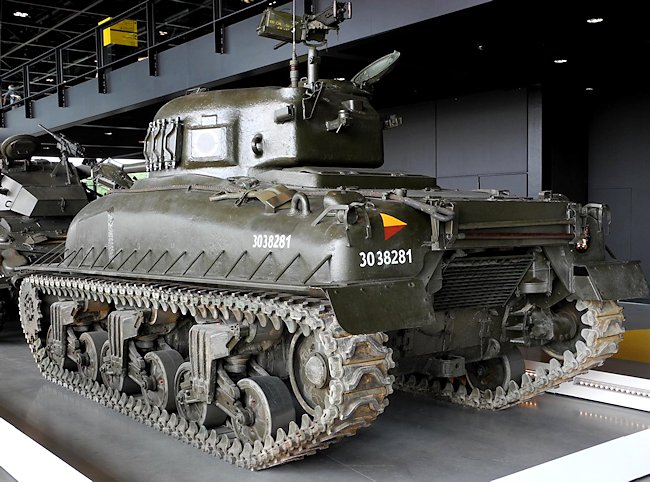
The Sherman M4A1E9 Medium Tank has a one-piece cast hull and turret. The rear hull has a shallow horseshoe shape cut into it. (Photos: Jan Wim Hasselman)
The E9 suspension
The M4A1E9 Sherman was built by Lima Locomotive Works in America. The early Sherman tanks had relatively thin tracks at 16 9/16th inches wide, and therefore would get stuck in muddy boggy ground. The tank designers tried different ways to reduce the ground pressure the Sherman tank exerted on the land it drove across. They designed track grouser extenders to increase the width of the track. Over 100,000 were produced and sent to units in north west Europe. By October 1944 there was enough to equip 650 Sherman tanks just in time for the winter rains and snow.
By April 1945 over 1.3 million track grouser extenders had arrived in theatre. The E8 Horizontal Volute Spring Suspension system HVSS increased the Sherman tank track width to 23 inches wide. The E9 modification used additional spacers that extended the suspension away from the tank hull by 4 1/2 inches. This enabled track grouser extenders to be fitted to the inside of the tank track as well as to the outside thus increasing the tank track width again.
Fitting the E9 kit to each suspension unit and track link was a time consuming job and not suitable for battlefield modifications. As a result the M4A1E9 variant arrived too late to take part in active service in WW2. Because the track was much wider from the original Sherman tracks they needed a wider track guard. The E9 modification kit included wider track guard fenders and 'fender braces' to support the extra weight.
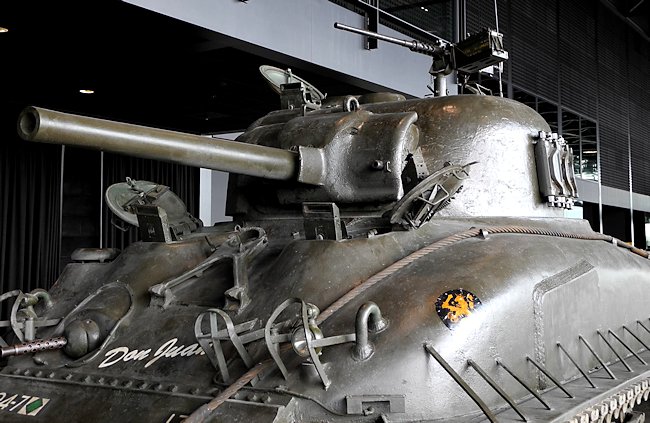
The Sherman M4A1E9 Medium Tank was armed with a 75mm gun that could fire HE and AT shells. Protruding driver and co-driver hoods were molded into the front glacis to give them extra room. Both could use periscopes when the their hatches were locked down in hostile environments. (Photos: Jan Wim Hasselman)
The 75mm Sherman Gun
The 75mm M3 gun of the Sherman fired several types of ammunition. A well trained crew in theory could fire 20 rounds per minute. The gun could fire high explosive HE shells. The official designation in US service for this shell was the M48 High Explosive round. It was suitable for use against infantry (either entrenched or in the open), as well as destroying buildings and un-armoured or lightly armoured vehicles. It could also fire smoke shells to cover the movement of tanks and infantry and prevent the enemy getting clear shots. The US M89 White Phosphorus round was used alongside standard smoke rounds.
The gun could fire two types of armour piercing rounds. The first was called Armour Piercing Capped, Ballistic Capped (APCBC. It is often colloquially referred to simply as Armour Piercing (AP). The round weighed 20 lbs, the projective itself weighing 15 lbs. It was the standard anti-tank ammunition used by the Sherman, capable of penetrating 68mm of armour set at a 30 degree slope at 500 yards, falling off at greater ranges to 60mm (1000 yards) and 47mm (2000 yards). The second AP round was called the Armour Piercing Discarding Sabot (APDS). It had a tungsten-cored projectile which was surrounded by a lighter alloy sheath which separated from the round as it left the muzzle.
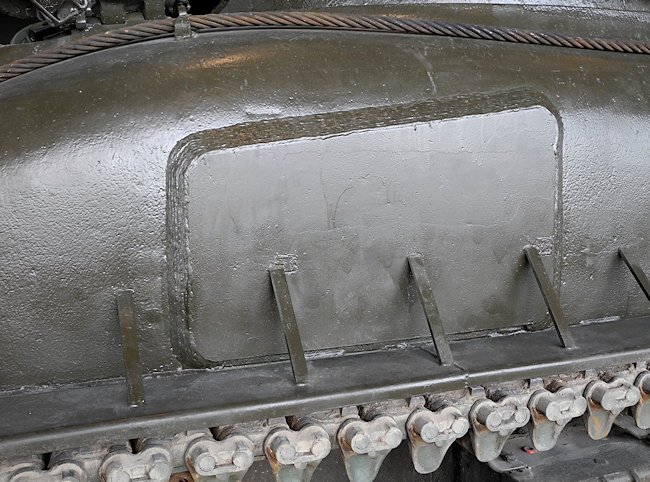
This extra piece of welded armour plate on the side of the Sherman M4A1E9 Medium Tank was to give the driver extra protection. The fender brackets were used on this tank to support the wider than normal track guard fender. (Photos: Jan Wim Hasselman)
Sherman tank crew maintenance responsibilities
The Sherman tank driver's job was to check fluid levels with engines running and off, check gauges, check lights, check periscope, engine and transmission compartments, clutch, air cleaners, throttle controls, fuel filter, inspect suspension at regular intervals, lubricate anything requiring it. The Co-Driver/hull machine gunner had to assist driver as required, check and oil bow .30 calibre Browning, test intercom, check periscope, clean compartment thoroughly.
The Gunner's maintenance responsibility was to clean and test main gun and co-axial .30 calibre machine gun, test turret traverse by hand and power, check periscope and telescopic sight, align sights as required, assist in checking suspension, oil weapons, check recoil and stabilizer systems, fill or bleed as required. The Loader-Operator on a Sherman tank had to check all electrical systems, carry out wireless netting drills, check periscope, assist driver with checking oil levels in engine, maintain Homelite, replenish drinking water, check all hatches, ports, etc., in turret and oil if necessary, check interior lights, check turret chamber and floor for any oil leaks from equipment.
The Sherman tank crew Commander had to supervise the other members of his crew and confirm they had done their maintenance jobs properly. He also had the responsibility of checking internal and external stowage, turret intercom, fire extinguishers, order other tests as required and complete all relevant paperwork.
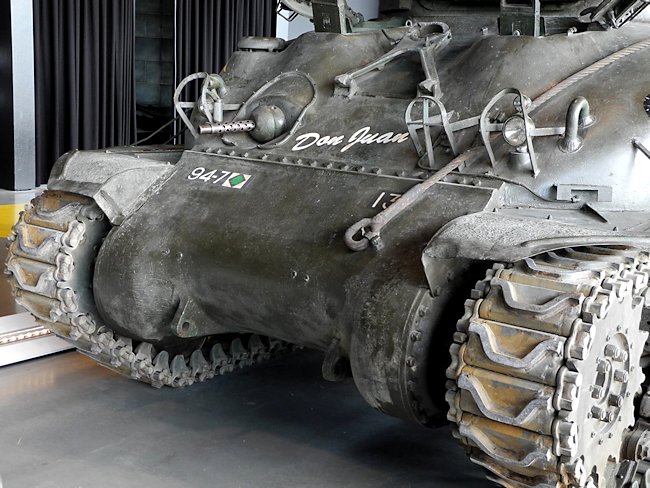
Notice the large gap between the inside of the tank track and the tank hull. This extra space was to allow room for an internal track extender that was part of the E9 modification kit. The internal and external track grouser extenders have not been fitted to the museum's tank. (Photos: Jan Wim Hasselman)
Extra equipment
When Sherman tanks rolled off the production line they came fitted with all the tools and equipment it was felt were needed by the tank crews. These included a Spade, full size pickaxe head and helve, hexagonal nut wrench, for removing road wheels, metal tow cable and engine starting crank. There was usually a spare bogie wheel and lengths of tank track carried somewhere on the tank as a replacement for accident or combat damaged parts.
The members of the (6th Canadian Armoured Regiment (1st Hussars)) took the opportunity to start making unauthorized modifications to their Shermans. They attached lengths of track from derelicts to the glacis plates (front of the tank) and the sides of the hull. The theory was that the additional armour would either deflect or slow down a round striking the tank. The crews were only too aware of the Shermans shortcomings and felt that they needed every additional advantage they could think of. The RCEME officers who saw these goings on were not impressed.
The extra weight would drive up fuel consumption and cause premature track and engine wear, they said. They also stated that the extra padding was illusory, that it would do nothing in the way of adding protection. The crewmen remained singularly unimpressed with these arguments. They didn't care a hoot about fuel, track or engine wear; they cared about getting across the next one hundred yards of ground and living to tell the story. If the extra armour was not real protection, that didn't matter either, they liked it and if it helped their morale and gave them more confidence in their vehicles then it was worth the expense.
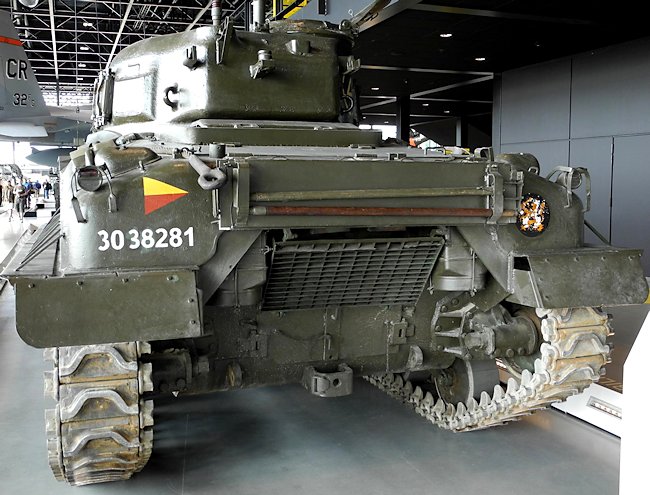
The large grill at the rear of this Sherman M4A1E9 Medium Tank is a Barber Coleman exhaust deflector. They are normally missing on restored monument tanks. It covers the two engine access doors. (Photos: Jan Wim Hasselman)
WW2 tank books

